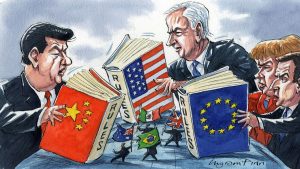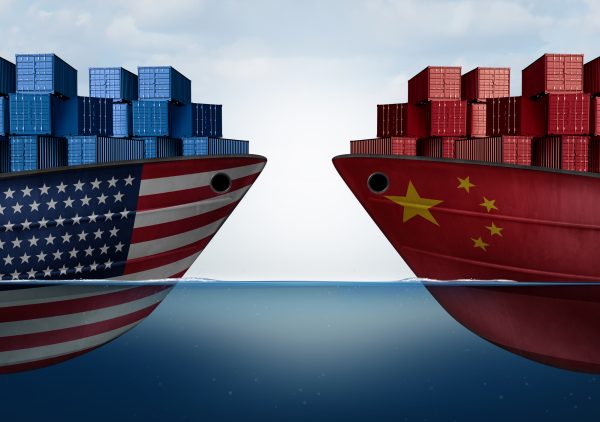Trade Wars and Global Economic Impact
Trade Wars and Global Economic Impact International trade increases efficiency and allows countries to participate in a global economy. But protectionist policies reduce economic growth and impede job creation.
In the short run, a trade war slows growth by around 0.4% in the United States and China (Chart 2). The indirect effects of escalated trade tensions and financial market disturbances also depress economic activity.
Tariff Imposition and Retaliation
A trade war leads to higher prices for consumers and businesses. This is because businesses have to pay more for the imported goods they need in order to make the final product. The impact is especially severe for industries that rely on global supply chains, such as manufacturers of electronics or automobiles. In those cases, the rise in costs can reduce consumption and economic activity.
Countries can also impose retaliatory tariffs in response to the actions of other governments. However, retaliatory tariffs often create issues between the imposing and targeted nations. For example, retaliatory tariff lists are usually designed to hurt the targeted country by penalizing specific sectors and geographic regions. This can lead to tensions between the countries and may initiate a tit-for-tat cycle that benefits no one.
Domestic firms in the imposing country can mitigate some of the negative effects of tariffs by sourcing inputs from other countries. This can increase firm competitiveness, but it can also make the final product more expensive to consumers. Furthermore, policy makers with short time horizons, such as those running for re-election, can find support for protectionism despite the risk of retaliation by China and other trading partners.
Supply Chain Disruptions
One of the biggest challenges in any trade war is the impact on global supply chains. Supply chain disruptions can be caused by natural disasters and conflict, as well as economic developments such as tariff increases. In many cases, these disruptions can be costly for the companies involved, resulting in price increases, delayed lead times, or even supply cuts.
For example, in the case of the current trade war between the US and China, studies show that American manufacturers incurred significant losses as a result of Chinese retaliatory actions. These costs were borne by consumers in the form of higher prices, and by workers who lost jobs or were forced to defer wage hikes and expansions. In addition, domestic farmers suffered from the loss of a significant market in China as a result of the trade war.
In general, a trade war increases uncertainty about future policy and therefore restrains investment. Moreover, financial markets may respond by increasing interest rates more quickly in response to higher inflation and a rise in financial stress. This can reduce new credit flows, limit industrial production and trade, and lower equity prices globally. These impacts are exacerbated when they occur in combination with other negative forces such as rising oil prices and elevated political risks.
Currency Fluctuations
The global economy operates on a floating exchange rate system where currency prices are determined by market forces and the supply and demand of currencies relative to one another. This means that the value of a country’s currency can fluctuate significantly from day to day. When a domestic currency depreciates, it can make imports relatively more expensive to domestic consumers and businesses that rely on foreign inputs. Conversely, when a country’s currency appreciates, it can make exports more affordable to foreign buyers.
This can directly impact trade balances, making it more difficult to maintain a positive trading surplus over time. It also can affect the cost of goods along international supply chains, which can impact profit margins for both manufacturers and their customers. This is why understanding and preparing for currency fluctuations is becoming an increasingly important advanced business acumen concept.
Market Volatility
When everything’s going well—strong economic growth, healthy stock portfolios—investors can become complacent. Then, something spooks the markets and price movements suddenly shift in a big way, up or down. These dramatic changes are called market volatility.
Market volatility is measured by the frequency and magnitude of those price movements, based on a statistical concept known as standard deviation. This measure looks at an asset’s return differences over time and compares them to its average returns, allowing traders to determine how much riskier an investment is.
There are many things that can cause heightened market volatility, including unexpected economic news, changes in Federal Reserve monetary policy and political/geopolitical events. While volatile markets can be disconcerting, they tend to be temporary and can provide excellent opportunities for investors who stay the course with a long-term investing plan.
It’s also important to remember that the world is interconnected, and that what happens in one country can have a direct impact on others. For example, a major leadership change in China could have significant economic impacts on the rest of the world, especially if that country has a trade surplus with the U.S. or is a major exporter of energy.
Trade Balances and Deficits
In the long run, trade wars depress global economic growth. As tariffs increase the cost of imports, consumers must spend less and firms will delay investment and wage increases. Exporting nations must also cut costs or lose sales, which can result in layoffs. The longer a trade war lasts, the worse the effect on global GDP. For example, a recent blog post by Paul Krugman suggests that a generalized tariff increase of 30 to 60 percentage points would cause a global real GDP loss of 3% to 4%.
Some economists, including CFR’s Benn Steil and Emma Smith, argue that protectionist policies would be counterproductive since blocking imports without changing underlying savings and investments levels simply raises the value of the currency and hurts exports as well.
Others, like Peterson Institute economists C. Fred Bergsten and Joseph E. Gagnon, blame China’s currency manipulation and state involvement in the economy for widening the US trade deficit. But experts warn that trade deficits eliminate millions of high-wage manufacturing jobs, drive down wages for production workers, and reduce domestic investment in research and development. They also strain international relations and foster an atmosphere of economic nationalism. The US-China tariffs imposed to date, for example, have mainly affected intermediate inputs and capital equipment—goods that are less visible to households but essential for firms to make other goods.

Sectoral Impacts
Many sectors in the economy are interlinked. Companies within the oil and gas industry, for example, compete with each other, but they also share resources. In the same way, the manufacturing sector includes companies that are in direct competition with each other but that rely on inputs from other industries to produce their goods. The primary sector represents companies involved in extracting natural resources and agriculture. The secondary sector consists of companies that manufacture, build and process products. Finally, the tertiary sector consists of companies that retail or market the goods they produce.
The growing trend toward protectionism worries some economists, who view free trade as beneficial to both developed and developing countries by advancing world productivity and global consumer welfare. For instance, the EU is worried that a flood of cheap electric vehicles (EVs) from China will undermine its own industry.
For emerging markets and developing economies (EMDEs), the current slowdown in global growth exacerbates challenges such as fiscal policy procyclicality, persistent inflation and trade fragmentation. Global cooperation is needed to address these issues and boost investment and long-term prospects.
Policy Responses
As businesses pass higher tariff costs to consumers, purchasing power diminishes and economic activity can slow. This is especially true for industries that rely on global supply chains, such as electronics or automobiles. Tariffs can also distort price signals, making it difficult to match supply with demand or to allocate resources in ways that maximize global productivity.
However, some countries benefited from the trade war. For example, Mexico and Vietnam increased their exports of products subject to US-China tariffs. Similarly, China’s tariff-induced increase in exports of smartwatches to the US pushed its overall exports to that market up, while its other global markets saw smaller increases.
These trends were driven primarily by heterogeneous responses to US-China tariffs, rather than by specific specialization patterns. Bystander countries with upward-sloping production curves – such as South Africa and the Philippines – also saw large increases in their exports of products targeted by US-China tariffs.
This is likely because they were able to fill gaps left by the loss of sales in their traditional markets. Moreover, these bystander countries were able to expand into new markets. In contrast, countries with steep downward-sloping production curves – including Spain, Egypt and Israel — did not see the same gains in exports.



